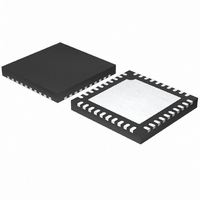MAX6956ATL+ Maxim Integrated Products, MAX6956ATL+ Datasheet - Page 5

MAX6956ATL+
Manufacturer Part Number
MAX6956ATL+
Description
IC DRVR DSPL LED 40-TQFN
Manufacturer
Maxim Integrated Products
Datasheet
1.MAX6956AAI.pdf
(24 pages)
Specifications of MAX6956ATL+
Display Type
LED
Interface
I²C
Current - Supply
180µA
Voltage - Supply
2.5 V ~ 5.5 V
Operating Temperature
-40°C ~ 125°C
Mounting Type
Surface Mount
Package / Case
40-TQFN Exposed Pad
Number Of Segments
28
Low Level Output Current
18000 uA
Operating Supply Voltage
2.5 V to 5.5 V
Maximum Supply Current
270 uA
Maximum Power Dissipation
2105 mW
Maximum Operating Temperature
+ 125 C
Mounting Style
SMD/SMT
Minimum Operating Temperature
- 40 C
Lead Free Status / RoHS Status
Lead free / RoHS Compliant
Configuration
-
Digits Or Characters
-
Lead Free Status / Rohs Status
Lead free / RoHS Compliant
The MAX6956 LED driver/GPIO peripheral provides up
to 28 I/O ports, P4 to P31, controlled through an I
patible serial interface. The ports can be configured to
any combination of constant-current LED drivers, logic
inputs and logic outputs, and default to logic inputs on
power-up. When fully configured as an LED driver, the
MAX6956 controls up to 28 LED segments with individual
16-step adjustment of the constant current through each
LED segment. A single resistor sets the maximum seg-
ment current for all segments, with a maximum of 24mA
per segment. The MAX6956 drives any combination of
discrete LEDs and CA digits, including seven-segment
and starburst alphanumeric types.
Figure 1 is the MAX6956 functional diagram. Any I/O
port can be configured as a push-pull output (sinking
10mA, sourcing 4.5mA), or a Schmitt-trigger logic input.
Each input has an individually selectable internal pullup
resistor. Additionally, transition detection allows seven
ports (P24 through P30) to be monitored in any mask-
able combination for changes in their logic status. A
detected transition is flagged through a status register
bit, as well as an interrupt pin (port P31), if desired.
The Typical Operating Circuit shows two MAX6956s
working together controlling three monocolor 16-seg-
SSO P/D IP
5–24
2, 3
25
26
27
28
—
—
—
1
4
28-Port LED Display Driver and I/O Expander
SSOP
5–32
2-Wire-Interfaced, 2.5V to 5.5V, 20-Port or
PIN
2, 3
—
—
33
34
35
36
—
1
4
_______________________________________________________________________________________
Detailed Description
37, 38, 39
11, 20, 31
T Q F N
12–19,
21–30
1–10,
36
40
32
33
34
35
—
—
P 12–P 31
P4–P31
NAME
GND
ISET
N.C.
SDA
AD0
SCL
AD1
V+
EP
Segment Current Setting. Connect ISET to GND through a resistor (R
the maximum segment current.
Ground
Address Input 0. Sets device slave address. Connect to either GND, V+, SCL,
SDA to give four logic combinations. See Table 3.
LED Segment Drivers and GPIO. P12 to P31 can be configured as CA LED
drivers, GPIO outputs, CMOS logic inputs, or CMOS logic inputs with weak
pullup resistor.
LED Segment Drivers and GPIO. P4 to P31 can be configured as CA LED
drivers, GPIO outputs, CMOS logic inputs, or CMOS logic inputs with weak
pullup resistor.
No Connection
I
I
Address Input 1. Sets device slave address. Connect to either GND, V+, SCL,
SDA to give four logic combinations. See Table 3.
Positive Supply Voltage. Bypass V+ to GND with minimum 0.047µF capacitor.
Exposed Pad (TQFN Only). Not internally connected. Connect EP to ground
plane for maximum thermal performance.
2
2
C-Compatible Serial Data I/O
C-Compatible Serial Clock Input
2
C-com-
ment-plus-DP displays, with five ports left available for
GPIO (P26–P31 of U2).
The port configuration registers set the 28 ports, P4 to
P31, individually as either LED drivers or GPIO. A pair
of bits in registers 0x09 through 0x0F sets each port’s
configuration (Tables 1 and 2).
The 36-pin MAX6956AAX has 28 ports, P4 to P31. The
28-pin MAX6956ANI and MAX6956AAI make only 20
ports available, P12 to P31. The eight unused ports
should be configured as outputs on power-up by writ-
ing 0x55 to registers 0x09 and 0x0A. If this is not done,
the eight unused ports remain as unconnected inputs
and quiescent supply current rises, although there is no
damage to the part.
The MAX6956 offers 20 or 28 I/O ports, depending on
package choice. These can be applied to a variety of
combinations of different display types, for example:
seven, 7-segment digits (Figure 7). This example
requires two MAX6956s, with one digit being driven by
both devices, half by one MAX6956, half by the other
(digit 4 in this example). The two drivers are static, and
therefore do not need to be synchronized. The
MAX6956 sees CA digits as multiple discrete LEDs. To
Register Control of I/O Ports and LEDs
FUNCTION
Across Multiple Drivers
Pin Description
ISET
) to set
5












